
Welcome to our blog post, where we embark on a journey into the captivating realm of raptors – the mighty falcons, hawks, and eagles.
These awe-inspiring birds of prey have long held a spellbinding grip on our collective imagination. But have you ever wondered what sets them apart?
Today, we peel back the layers and shine a light on the distinct characteristics that define each species. From their unique hunting strategies to their regal and formidable physical attributes, join us as we dive headfirst into the wondrous world of falcons, hawks, and eagles.
Brace yourself for an educational escapade that will leave you soaring with newfound knowledge about these extraordinary creatures.
What is the difference between a falcon and a hawk and an eagle
Contents
- 1 What is the difference between a falcon and a hawk and an eagle
- 2 Size Comparison of Falcons, Hawks, and Eagles
- 3 Flight Patterns of Each Bird of Prey
- 4 Distinguishing Features of Falcons, Hawks, and Eagles
- 5 Hunting Strategies Used by Raptors
- 6 Dietary Differences Between Raptors
- 7 Classification of Falcons, Hawks, and Eagles
- 8 Habitats Preferred by These Birds of Prey
- 9 Advantages of Being a Bird of Prey
- 10 Conclusion
Falcons, hawks, and eagles are majestic creatures that captivate us with their soaring flights and hunting prowess. While they may share similarities as raptors, each species possesses distinct characteristics that set them apart. In this article, we’ll delve into the differences between these magnificent birds and explore what makes each one unique.
Physical Appearance:
- Falcons: With their slender bodies and long, pointed wings, falcons exhibit a streamlined silhouette designed for speed. Notably, falcons boast a distinguishing notch in their beak called a “tooth,” which aids in swiftly killing their prey.
- Hawks: Hawks are larger than falcons but smaller than eagles. They possess broad wings and short, hooked beaks. Their plumage varies widely among different species, showcasing a stunning array of colors and patterns.
- Eagles: The true giants of the raptor world, eagles command attention with their massive size and powerful build. They feature long, broad wings and strong, curved beaks. Many eagle species possess distinctive white head or tail feathers.
Flight Abilities:
- Falcons: When it comes to aerial acrobatics, falcons reign supreme. Renowned for their speed and agility, they can achieve astonishing speeds during hunting dives, reaching over 200 miles per hour (320 kilometers per hour). Their long, pointed wings enable swift maneuvering through the air.
- Hawks: Hawks are versatile fliers, often soaring high in the sky using thermal updrafts to conserve energy. They exhibit impressive maneuverability while hunting and rely on surprise attacks to catch their prey.
- Eagles: Eagles possess remarkable strength and endurance in flight. They can soar for extended periods without flapping their wings by skillfully utilizing thermals. Their broad wings enable them to maintain stability and cover vast distances.
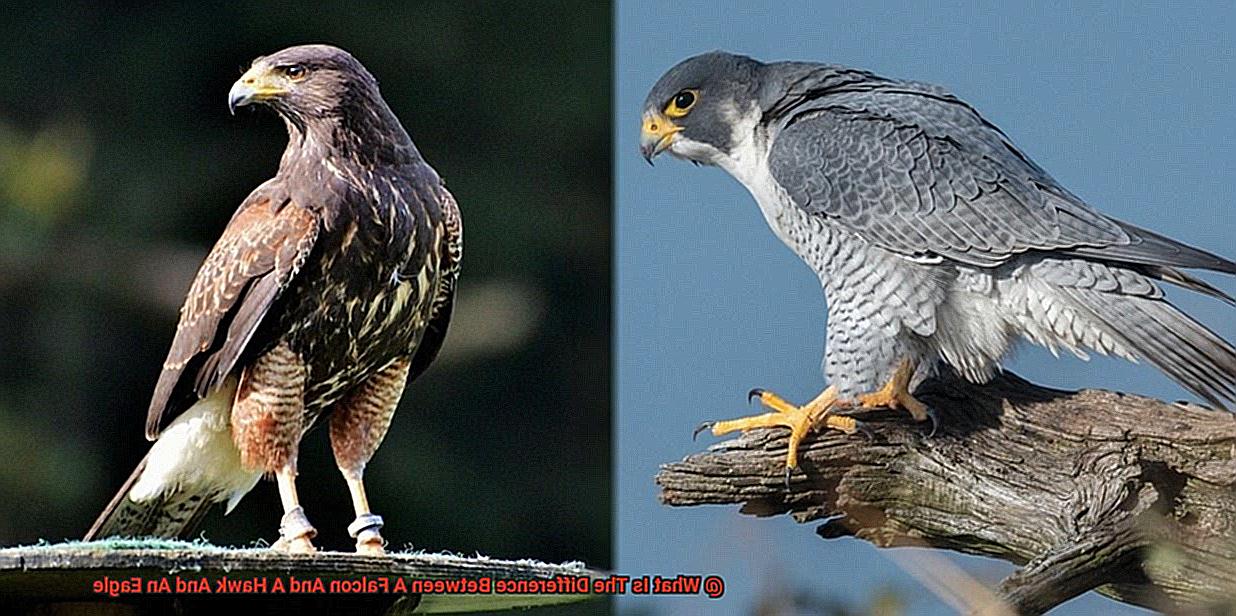
Hunting Techniques:
- Falcons: Falcons are renowned for their aerial hunting prowess. They use their speed and agility to chase down prey mid-air, often employing steep dives called “stoops” to catch smaller birds in flight. Their talons strike with precision and force.
- Hawks: Hawks primarily rely on their keen eyesight to spot prey from a distance while perched or soaring. Once they’ve identified a target, they swoop down swiftly, using their sharp talons to capture it. Hawks are ambush predators, surprising their prey with sudden attacks.
- Eagles: Eagles are opportunistic hunters that employ various techniques depending on the species and habitat. Some eagles hunt fish by swooping down to snatch them from the water’s surface, while others capture small mammals and birds. Their powerful talons ensure a secure grip on their prey.
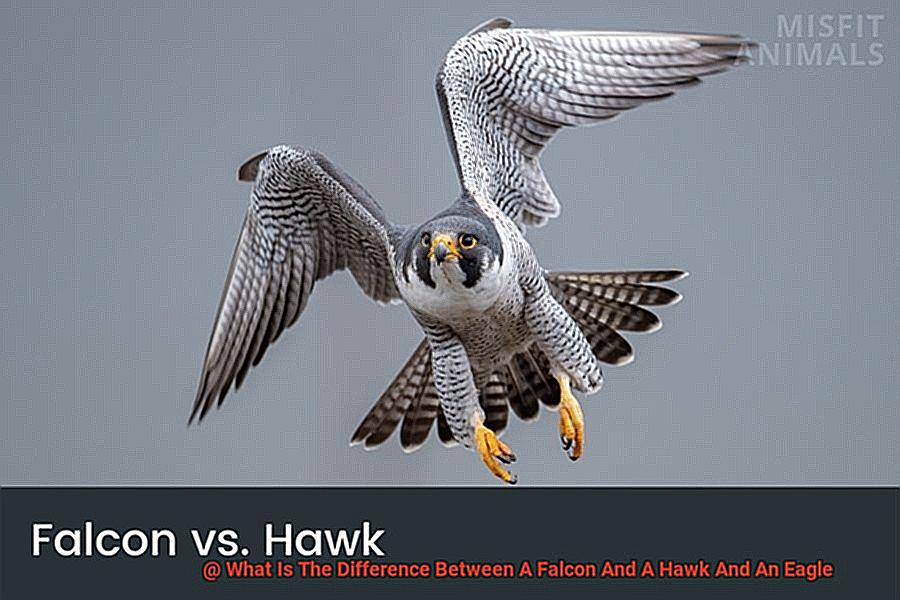
Size Comparison of Falcons, Hawks, and Eagles
Falcons, hawks, and eagles are all majestic birds of prey, but they differ in size, which affects their physical appearance and hunting strategies. Let’s take a closer look at how these differences play out.
Falcons: Speedy and Agile
Falcons are the smallest among the three, with an average length ranging from 9 to 21 inches and a wingspan of about 20 to 46 inches. Their compact size allows them to be incredibly agile and excel at high-speed aerial pursuits. Falcons are known for their breathtaking dives, reaching speeds of up to 240 miles per hour. With their streamlined bodies and long, pointed wings, they are built for speed and precision.
Hawks: Versatile Predators
Hawks are slightly larger than falcons, with an average length ranging from 18 to 26 inches and a wingspan of about 35 to 52 inches. Their size gives them the advantage of being able to hunt a wider range of prey compared to falcons. They have a more diverse hunting strategy, employing techniques such as soaring, hovering, and surprise attacks from perches. Hawks have a compact body shape like falcons but may have broader wings.
Eagles: Powerful Hunters
Eagles are the largest of the three, with an average length ranging from 28 to 40 inches and a wingspan of about 6 to 7 feet. Their size and strength allow them to tackle larger prey than falcons or hawks. Eagles often rely on soaring and gliding to conserve energy while scanning vast areas for potential prey. They have a bulkier build with broader wings that enable them to soar effortlessly.
Size Comparison:
Bird | Average Length | Wingspan
——————————————–
Falcons | 9-21 inches | 20-46 inches
Hawks | 18-26 inches | 35-52 inches
Eagles | 28-40 inches | 6-7 feet
It’s important to note that these size ranges are averages, and individual birds within each species can vary in size. Additionally, there are several species of falcons, hawks, and eagles, each with its own specific size characteristics.
Flight Patterns of Each Bird of Prey
Today, we’re embarking on an exhilarating journey through the skies to explore the flight patterns of our feathered friends – falcons, hawks, and eagles. Strap in and hold on tight, because we’re about to witness some awe-inspiring aerial acrobatics.
Falcons: Need for Speed
Falcons are the daredevils of the avian world. With their sleek bodies and long, pointy wings, they’re built for speed. These raptors are known for their jaw-dropping hunting dives or stoops, where they can reach mind-boggling speeds of up to 240 miles per hour. Talk about living life in the fast lane. Their flight pattern consists of rapid wing beats followed by short glides, allowing them to maneuver swiftly through the air and make lightning-quick turns.
Hawks: Soaring High and Mighty
Next up, we have the hawks – the masters of soaring and gliding techniques. With broader wings than falcons, these magnificent creatures are designed for efficiency rather than speed. Hawks rely on rising air currents or thermals to gain altitude and conserve energy during their flights. Picture them gracefully circling in the sky, scanning the landscape below for their next tasty treat. They can stay aloft for extended periods without flapping their wings, covering vast distances effortlessly.
Eagles: The Apex Predators Take Flight
Last but certainly not least, we have the kings of the sky – eagles. These majestic birds are the epitome of power and grace. With their impressive size and broad wingspan, eagles have a flight pattern that combines elements of both falcons and hawks. They soar and glide effortlessly through the air, just like hawks, but with a touch of falcon-like agility. Eagles can reach impressive speeds during their hunting dives, although they’re not as fast as falcons. Nevertheless, their aerial maneuvers are a sight to behold.
How Do These Flight Patterns Serve Their Hunting Styles and Habitats?
Each bird of prey has honed its flight pattern to suit its specific hunting style and habitat.
- Falcons, with their incredible speed and agility, thrive in open areas like grasslands and deserts. Their swift flight allows them to pursue fast-moving prey such as small birds with exceptional precision.
- Hawks, with their soaring and gliding prowess, excel in forested areas or open fields. Their flight pattern enables them to spot prey from a higher vantage point, making it easier to swoop down for the kill.
- Eagles, with their combination of soaring and gliding abilities, are versatile hunters that adapt to various habitats. Whether it’s mountains, forests, or coastal regions, these regal hunters can navigate with ease.
Distinguishing Features of Falcons, Hawks, and Eagles
FALCONS:
- Speed and agility: Falcons are renowned for their incredible speed and agility. With long, pointed wings and a streamlined body shape, they can reach astonishing speeds in flight.
- Size: Falcons have a wingspan that ranges from 2 to 4 feet, depending on the species.
- Hunting technique: Falcons are aerial hunters, using their speed to dive at high velocities and catch their prey mid-air.
- Plumage: Falcons typically have a combination of dark and light feathers on their body, with some species displaying distinct markings on their faces.
- Habitat: Falcons are commonly found in open areas such as grasslands or deserts, where they can easily spot their prey from above.
- Migration: Falcons are migratory birds, traveling long distances during certain times of the year in search of food and breeding grounds.
HAWKS:
- Size: Hawks are larger and more robust compared to falcons. They have broad wings and a wide tail that aids in their effortless soaring through the air.
- Hunting technique: Hawks are often seen perched on treetops or utility poles, scanning the ground for potential prey. They then swoop down to capture their prey with their sharp talons.
- Plumage: Hawks often have mottled or streaked feathers that help them blend into their surroundings when hunting.
- Habitat: Hawks are adaptable birds that can be found in various habitats, including forests, fields, and even urban areas.
- Migration: Hawks also migrate but tend to follow food sources rather than a set migratory path.

EAGLES:
- Size: Eagles are the largest of the three birds, known for their impressive size and strength. They have broad wings with a wingspan that can reach up to 7 feet.
- Hunting technique: Eagles often fly at great heights before diving into the water to catch fish, their primary food source. They have strong legs and sharp talons for capturing their prey.
- Plumage: Eagles typically have dark brown feathers with white or cream-colored heads and tails.
- Habitat: Eagles prefer to inhabit coastal areas, lakes, or rivers where they can find a steady supply of fish.
- Migration: Eagles exhibit relatively short migrations and may stay in the same general area throughout the year if there is an abundant food supply.
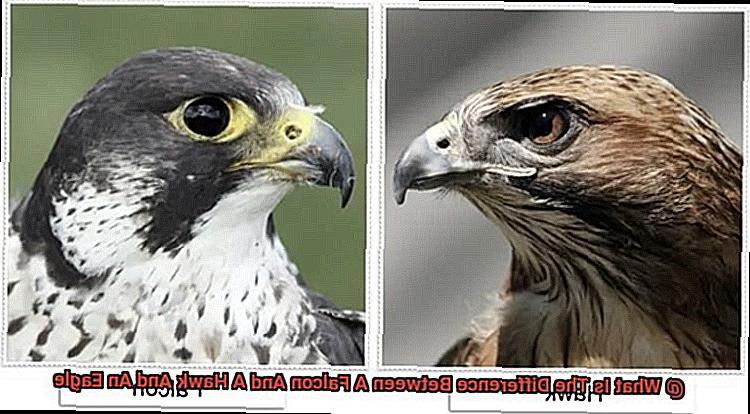
Hunting Strategies Used by Raptors
Birds of prey, commonly known as raptors, encompass a diverse group of hunters that includes falcons, hawks, and eagles. Each species exhibits its own distinctive hunting strategies, tailored to their specific physical attributes and habitats. In this article, we will delve into the fascinating world of these magnificent birds, exploring their hunting techniques and shedding light on their remarkable adaptations.
Falcons: The Speed Demons
Falcons are renowned for their unparalleled speed and agility in flight. Equipped with long, pointed wings and a streamlined body, they are built for speed. Falcons primarily employ a hunting technique known as the stoop, where they dive from great heights to strike their prey with precision. Their sharp talons swiftly capture the unsuspecting victim mid-flight. This strategy is particularly effective when targeting small birds or insects on the wing.
Hawks: Masters of Soaring and Swooping
Hawks possess broader wings and a more robust physique compared to falcons. They employ a combination of soaring and gliding techniques to hunt their prey. Often seen circling high above their territories, hawks utilize their excellent eyesight to spot potential targets below. Once a suitable prey item is detected, they descend rapidly in a breathtaking swoop, using their powerful talons to seize the victim.
Eagles: The Aerial Kings
With their imposing size and impressive wingspans, eagles are the epitome of regal predators. These majestic birds rely on their exceptional eyesight to scan vast landscapes for signs of movement or potential prey. Often perched on elevated vantage points such as trees or cliffs, they patiently await an opportune moment to launch into flight. Eagles then glide gracefully towards their target, employing their sharp talons to snatch and capture prey, which can range from fish to small mammals.
Adapting and Surviving
While the aforementioned hunting strategies serve as general patterns, it is crucial to recognize that raptors are adaptable creatures. Factors such as prey availability, seasonal variations, and habitat conditions can influence their hunting techniques. Over millions of years, these birds have honed their skills to thrive in diverse environments, showcasing their exceptional ability to adapt and survive.
Dietary Differences Between Raptors
When it comes to dining preferences, falcons, hawks, and eagles each have their own distinct tastes. Let’s take a closer look at how these magnificent raptors differ in their diets.
Falcons: The Speedy Avian Hunters
Falcons are renowned for their lightning-fast speed and aerial acrobatics. With their sleek bodies and pointed wings, they specialize in chasing down agile birds mid-air. Pigeons, doves, and songbirds are their preferred prey. Picture a falcon diving at astonishing speeds to snatch its meal in a mid-air stoop – it’s a sight to behold.
Hawks: The Versatile Predators
Hawks boast broader wings and a robust build compared to falcons. This makes them more versatile hunters with a wider range of prey options. While small mammals like mice, squirrels, and rabbits are their mainstay, hawks also consume birds, reptiles, amphibians, and even insects. They employ a mix of soaring and perching techniques to locate and snatch their prey on the ground or in trees.
Eagles: The Majestic Fishermen
Eagles are the heavyweight champions among raptors. With their broad wings and powerful build, they excel at soaring to great heights. These regal birds primarily feed on fish and water birds, showcasing their impressive diving skills when snatching prey from bodies of water. However, eagles are also opportunistic hunters that won’t say no to small mammals or carrion if it crosses their path.
It’s important to note that while these dietary preferences hold true for most falcons, hawks, and eagles, there can be some variations within each species. Some falcons may go after larger prey or insects, while certain hawks may specialize in hunting specific mammals. Additionally, the availability of prey in different habitats can influence the diet of these raptors.
Classification of Falcons, Hawks, and Eagles
Falcons, hawks, and eagles are fascinating birds of prey that belong to the same taxonomic family, Accipitridae. However, they are classified into different subfamilies based on their unique characteristics and adaptations.
Falcons (Subfamily Falconinae):
- Known for their exceptional speed and agility in flight.
- Long, pointed wings and a streamlined body shape.
- Pursue their prey with great precision.
- Falcon species include the Peregrine Falcon, Merlin, and American Kestrel.
Hawks (Subfamily Accipitrinae):
- Have broader wings and a more robust body structure.
- Known for their keen eyesight and powerful talons.
- Capture and kill their prey using their sharp talons.
- Hawk species include the Red-tailed Hawk, Cooper’s Hawk, and Sharp-shinned Hawk.

Eagles (Subfamily Accipitrinae):
- Largest of the three raptors, with some species having a wingspan of over 7 feet.
- Broad wings for soaring and strong legs equipped with sharp talons.
- Capture and carry their prey using their powerful talons.
- Eagle species include the Bald Eagle, Golden Eagle, and Harpy Eagle.
Size:
- Falcons: Generally smaller, ranging from 9 to 21 inches in length.
- Hawks: Can measure anywhere from 16 to 26 inches in length.
- Eagles: The largest, ranging from 26 to 40 inches in length.
Coloration:
- Falcons: Dark-gray or brownish-gray plumage with distinct patterns on body and wings.
- Hawks: Wide range of colors including brown, gray, and black.
- Eagles: Dark-brown plumage with white or yellowish feathers on head and neck.
Hunting Behavior:
- Falcons: Aerial hunters relying on speed to catch birds mid-flight.
- Hawks: Hunt from perches or by soaring in circles before diving onto prey.
- Eagles: Employ various hunting strategies including soaring, searching from high perches, or engaging in aerial pursuits.
Diet:
- Falcons: Primarily feed on small to medium-sized birds.
- Hawks: Varied diet including birds, mammals, reptiles, and insects.
- Eagles: Opportunistic hunters feeding on a wide range of prey including fish, small mammals, and birds.
Habitat:
- Falcons: Found worldwide except for Antarctica and some oceanic islands, preferring open habitats such as grasslands and deserts.
- Hawks: Inhabit various ecosystems from forests to grasslands.
- Eagles: Typically found near large bodies of water like lakes, rivers, or coastal areas.
In conclusion, falcons, hawks, and eagles are impressive birds of prey with distinct characteristics in terms of classification, size, coloration, hunting behavior, diet, and habitat. Understanding these differences can help us appreciate their unique adaptations and roles in their respective ecosystems.
Habitats Preferred by These Birds of Prey
Falcons: Speed Demons of the Skies
Falcons are known for their incredible speed and agility, making them the fighter jets of the bird world. These magnificent birds prefer open spaces such as grasslands, deserts, and coastal areas. They thrive in areas with ample visibility, allowing them to spot their prey from above. Falcons are often found nesting on cliffs or tall trees, giving them a strategic vantage point to scan the surroundings for potential meals. Interestingly, some species of falcons have adapted to urban environments and can be found nesting on man-made structures like buildings or bridges.
Hawks: Adaptable Aerial Snipers
Hawks are versatile hunters that can be found in a wide range of habitats. From forests to grasslands, mountains to urban areas, hawks have mastered the art of adaptation. With their keen eyesight and ability to soar high above the ground, they are skilled aerial snipers. Hawks typically build their nests in tall trees or on ledges, providing them with a clear view of their surroundings. This strategic positioning allows them to spot prey and strike with precision.
Eagles: Majestic Rulers of Remote Territories
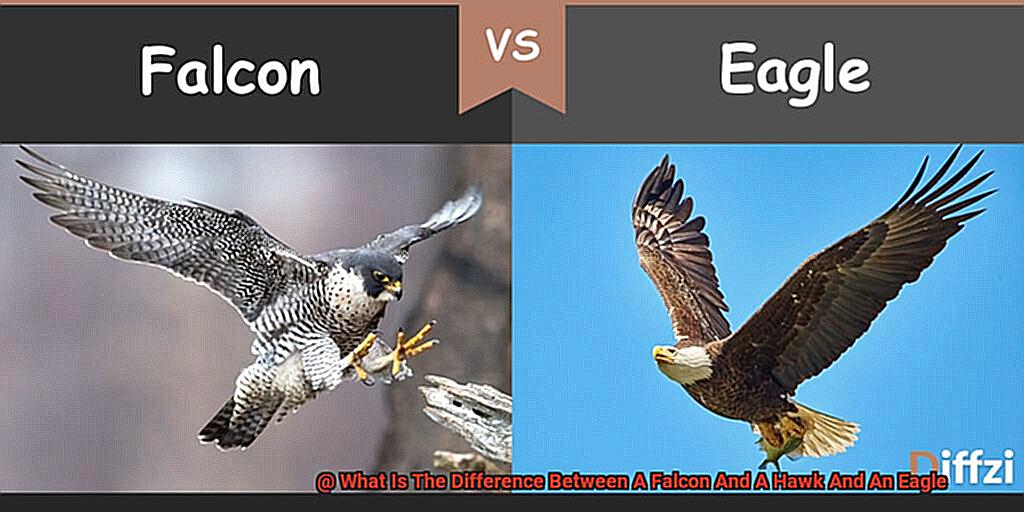
Eagles, being the largest birds of prey, require larger territories and often inhabit more remote and secluded areas. These majestic rulers are commonly found in mountainous regions, near bodies of water like rivers or lakes, and in large forests. Eagles prefer habitats with an abundant food supply and minimal disturbance. They build their nests in tall trees or on cliffs, providing them with a secure location to raise their young.
High Perches and Mixed Habitats
One common trait among these birds is their preference for high perches. These perches serve multiple purposes – they allow these birds to survey their surroundings, spot potential prey, and also keep them safe from ground-dwelling predators. The habitats of falcons, hawks, and eagles often provide a mix of open spaces for hunting and dense vegetation for nesting.
Advantages of Being a Bird of Prey
Birds of prey, including falcons, hawks, and eagles, possess a unique set of advantages that make them remarkable creatures in the animal kingdom. From their superior hunting abilities to their adaptability and symbolic significance, these magnificent birds have earned their rightful place as apex predators. Join me as we explore the advantages that set them apart and make them truly awe-inspiring.
Superior Hunting Abilities:
With sharp beaks and powerful talons, birds of prey possess exceptional hunting skills. Their keen eyesight allows them to spot their prey from great distances, even while soaring high in the sky. This, coupled with their incredible speed and agility, enables them to swiftly swoop down on unsuspecting prey, making them highly efficient hunters.
Adaptability:
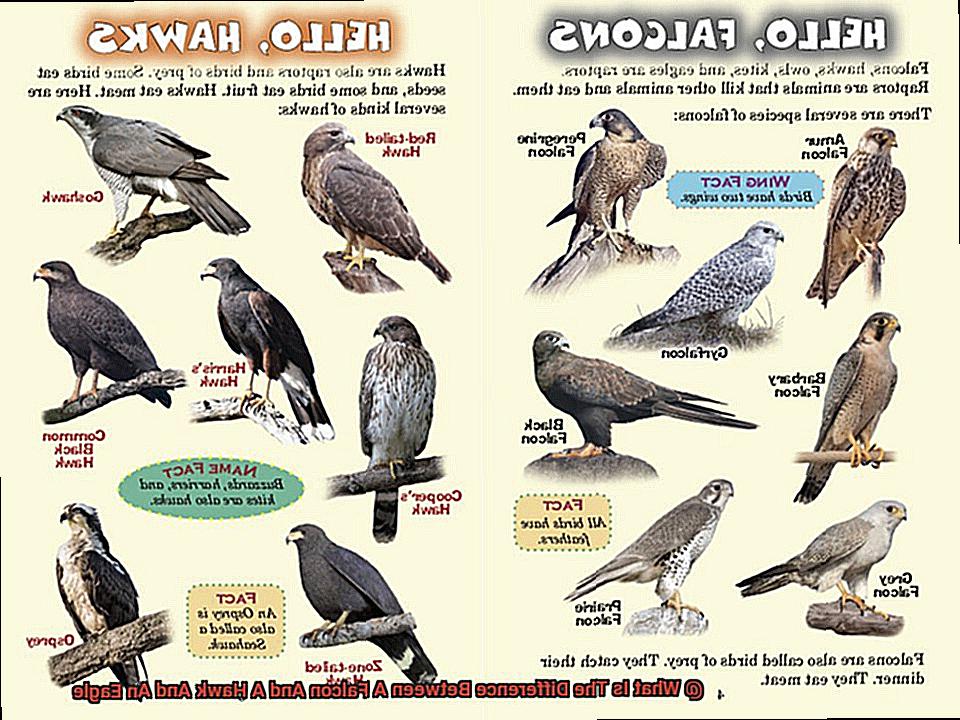
Birds of prey have the remarkable ability to adapt to various environments and habitats. Whether it’s the vast deserts, lush forests, or towering mountains, falcons, hawks, and eagles can be found thriving in diverse geographical locations around the world. This adaptability gives them an advantage over other species as they can easily find food sources and establish territories.
Apex Predators:
Being at the top of the food chain, birds of prey play a crucial role in maintaining the balance of ecosystems. They control populations of smaller animals, such as rodents and small mammals, preventing overpopulation and maintaining ecological stability. Their presence ensures a healthy and flourishing environment for other species.
Long Lifespan:
Compared to many other bird species, birds of prey generally have longer lifespans. Their exceptional hunting skills allow them to secure a stable food source, avoiding starvation or malnutrition. Establishing territories and defending them fiercely reduces competition for resources and ensures their survival.
Flight:
Flying is undoubtedly one of the most significant advantages of being a bird of prey. Their strong wings enable them to soar effortlessly through the skies, providing them with a broader range of movement and access to different areas. Flight allows them to cover large distances in search of food, mates, or suitable nesting sites. It also serves as an escape mechanism from potential threats or predators on the ground.
Symbolic Significance:
Birds of prey have been revered and admired by humans for centuries. Their majestic appearance, grace in flight, and predatory prowess have resulted in their association with power, strength, and freedom. This symbolic significance has led to their presence in mythology, folklore, and even national emblems. Being a bird of prey grants them respect and admiration from humans, further enhancing their advantageous position.
Conclusion
In conclusion, the distinction between a falcon, hawk, and eagle lies in their unique characteristics.
Falcons are known for their incredible speed and agility, capable of reaching astounding speeds during their aerial hunts. Hawks, on the other hand, possess sharp vision and keen hunting skills, often seen soaring high above open fields in search of prey.
Lastly, eagles are renowned for their majestic presence and powerful wingspan, enabling them to soar effortlessly through the sky.


